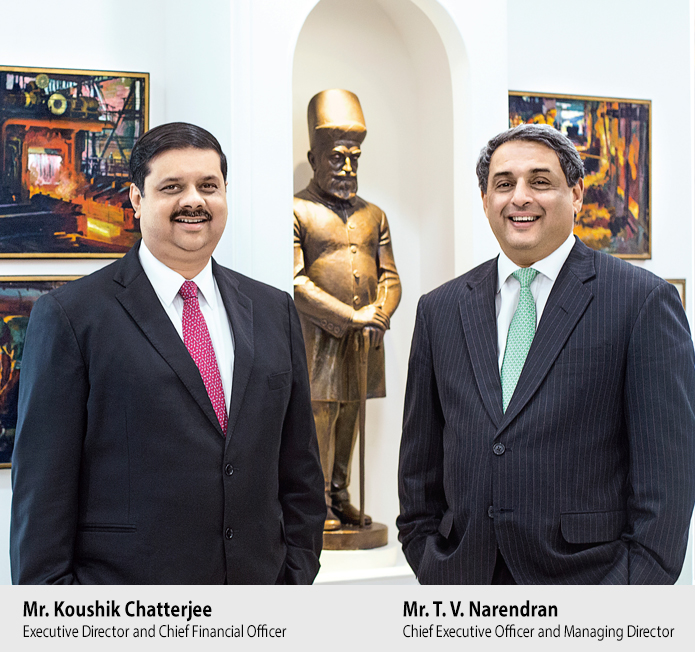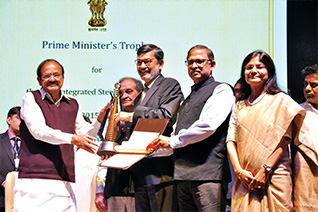 Report Menu
Report Menu
A dialogue with the CEO and CFO

Our focus over the next decade will also be to work towards becoming an industry leader in research and development
Where do you see the global economy and the global steel market today? And where does India stand?
During the last 12 months, global economic growth has picked up and has been broad-based. Many developed economies witnessed recovery in investments and domestic demand and there was a general buoyancy in the labour markets with low level on unemployment. Amongst the larger economies, China witnessed a gradual slowdown in the economic activity but continued to grow in line with expectations. Global steel markets continued their recovery in FY 2017-18 as the global steel demand grew by approximately 2% as compared to the previous year. Steel exports from China declined due to capacity closures leading to a favourable demand-supply balance both in China as well as in the international markets. This resulted in improved capacity utilisations in the industry, better steel prices and spreads, resulting in an improved industry performance for the year.
India too witnessed growth in steel demand owing to growth across the steel consuming sectors and the Government’s continuous push on infrastructure spending. We believe that the steel demand in India will continue to increase in the future with increased capital and infrastructure investments, including the Make in India initiative, higher urbanisation trends, focus on a wider and more inclusive banking network and transition to a more formal economy, including digital initiatives even in rural areas. The Government’s initiatives to strengthen the domestic steel industry are also reflected in the National Steel Policy. The Policy endeavours to make the Indian steel industry self-sufficient, sustainable, efficient, cost efficient and internationally competitive. Tata Steel’s long-term strategy is to focus on growing in India. This year has been particularly significant for the Indian steel industry, with several ‘stressed’ steel assets being put under the insolvency and bankruptcy proceedings. The outcome of the process is going to change the industry structure, resulting in consolidation within the industry and/or entry of new players.
How has the Tata Steel Group performed in FY 2018?
The performance of the Tata Steel Group in FY 2017-18 has been quite satisfying. Our consolidated revenues stood at ₹1,33,016 Cr. as against ₹1,17,420 Cr., reflecting an increase of 13% over the previous year. The EBITDA for the year at ₹22,045 Cr. was 29.5% higher than the previous year. During the year, we reported a consolidated PAT of ₹17,763 Cr. as against a consolidated loss of ₹4,169 Cr. in the previous year. The profit includes an exceptional gain due to non-cash accounting surplus arising from the formation of the new British Steel Pension Scheme (BSPS).
What measures have you taken to optimise growth in India?
FY 2017-18 has been an important year for Tata Steel. We had, at the beginning of the year, expressed our intentions to increase our capacity in India and significantly grow in line with the market demands. We are happy to report that our efforts have shown a positive and rewarding outcome. We were successful in our endeavour to ramp up operations at our greenfield plant in Kalinganagar, Odisha. The plant has achieved its rated capacity and is in its next phase of expansion, which is progressing well. We have also successfully completed the acquisition of Bhushan Steel Limited under the Insolvency & Bankruptcy Code, 2016. This acquisition will allow Tata Steel to make optimum utilisation of the facilities at Bhushan Steel. This will help us to supplement our existing facilities and will also provide us with the opportunity to scale-up our operations at a faster pace in India, thereby expanding our footprint in the country.
Can you comment on the restructuring activities at Tata Steel Europe?
During the year, we successfully completed the restructuring of the BSPS in Europe. The defined benefit plan has been closed and we have introduced a new closed scheme. Approximately 69% members of the erstwhile BSPS continue as members in the new scheme. We expect that the new scheme will be more sustainable for the future.
During the year, we also signed a Memorandum of Understanding (MoU) with thyssenkrupp AG to form a 50:50 joint venture by combining the flat product businesses of the two companies in Europe. This is an important milestone for us, which we believe will help us achieve our objective with regard to having a wider European portfolio strategy and diversify our business in the region. Through this joint venture, we expect to derive significant synergies and improve our capacity utilisations in Europe. We expect the transaction to be completed by the end of this year.
Can you provide your views on the financing strategy of the Company?
As we mentioned earlier, the Company is pursuing organic as well as inorganic growth prospects. We are continuously reviewing our financing requirements to fund the Company’s growth projects and capital expenditure programmes and to maintain a strong liquidity position.
During the year, the Board approved the overall financing plan for the Tata Steel Group. Accordingly, the Company issued fully and partly paid ordinary shares by way of rights issue aggregating to ₹12,800 Cr., being one of the largest issues in the country. Also, ABJA Investment Co., a wholly-owned subsidiary of Tata Steel, issued a dual tranche of USD1.3 billion unsecured bonds in the international markets. The success of both these issues are a testimony to the investors’ confidence in the long-term strategy of the Company.
We also periodically review our investment portfolio. During the year, we realised approximately ₹3,500 Cr. through portfolio divestment.
What are the new initiatives of the Tata Steel Group?
While our primary focus is on growth and expansion, our focus over the next decade will also be to work towards becoming an industry leader in research and development. We have commenced work in India as well as in Europe to develop a roadmap and achieve this goal. We have also started work on developing the alternate/new materials business, including graphene and fibre-reinforced polymers. We expect to commence work on ceramics soon.
We have also launched a digital transformation programme across the Company to embed and leverage digital technologies to drive greater cost effectiveness and to enhance stakeholder experience.
We are making good progress in the area of services and solutions and the revenue streams have now crossed USD150 million.
What steps are you taking towards sustainability and climate change?
We have always aimed to grow in a sustainable manner and are putting in place policies that support this endeavour. We are a signatory to the United Nations Global Compact (UNGC) and we submit to UNGC’s Communication of Progress on the ten principles of sustainability.
We are committed to reducing the impact of our operations on the environment and reducing our carbon footprint. We aspire to be the industry benchmark in terms of improving our CO2 performance and are putting in efforts to achieve the same. Our endeavour is to play a leadership role in addressing the challenges of climate change. We have formulated a climate change strategy based on key themes. In Europe, we have undertaken various initiatives such as HIsarna & Carbon Capture and Utilisation. The objective of developing this technology is to reduce the CO2 emissions. It is a joint effort of all major steel manufacturers in Europe and is in the final stages of testing.
In India, we have also launched a steel recycling business. We aim to shape the steel recycling industry in India and leverage opportunities in this space. Over the next few years, we expect the regulatory environment to unlock opportunities in this area.
The health and safety of people working at our various site locations is our topmost priority and we are committed to building a safer and healthier working environment for people to work in our operating locations. We have enhanced our focus to ensure safety in the areas of Organizational Safety Competency & Capability Improvement and Contractor Safety Risk Management, among others.
What role do you play in the development and upliftment of communities?
We have always been mindful of the impact of our operations on the communities around us and have taken steps to ensure the health and economic prosperity of our neighbouring communities. During the year, we undertook various Corporate Social Responsibility (CSR) initiatives in the areas of health, education, livelihood, sports and infrastructure development with indigenous communities in the areas of operations of the Company. We have partnered with various organisations to work for the upliftment of our communities and will continue to put in efforts to bring about their sustainable development.

Prime Minister’s Trophy for ‘Best Integrated Steel Plant’
for the
assessment years 2014-15 and 2015-16
We are making good progress in the area of services and solutions and the revenue streams have now crossed USD150 million.

Capacity Expansion at State-of-the-art
Kalinganagar Steel Plant
We were successful in our endevour to ramp up operations at our greenfield plant in Kalinganagar, Odisha. The plant has achieved its rated capacity and is in its next phase of expansion, which is progressing well.

Amongst the top 3 global steel companies and the only company in India to be gold rated in the Dow Jones Sustainability Indices (DJSI) Assessment 2017
We aspire to be the industry benchmark in terms of improving our CO2 performance and are putting in efforts to achieve the same. Our endeavour is to play a leadership role in addressing the challenges of climate change.
